Radio. Photography. Microwaves. Television. The Internet. What do these things have in common? They’re all forms of ‘light-based’ technology. Without light and its basic properties we wouldn’t have these and many other modern tools. That said, without light and its basic properties we probably wouldn’t exist either. Without the Sun, what would heat up our planet? What would provide light for the photosynthesizing organisms that form the base of most of our planet’s food webs?
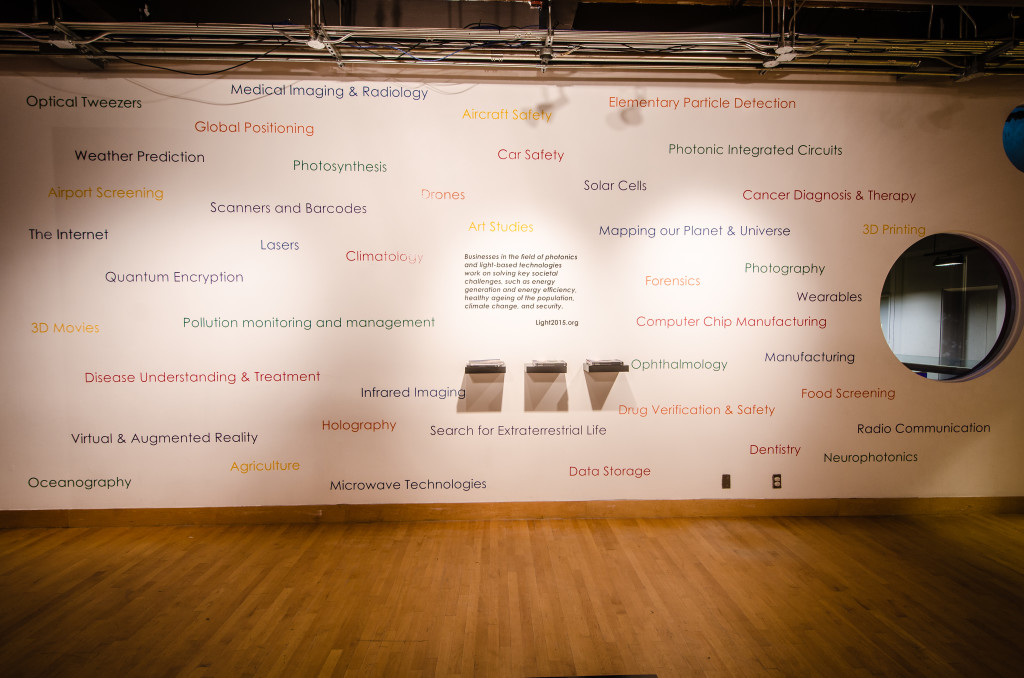
The word wall at the end of the exhibition highlights the important ways that light is used in our everyday lives. Photo credit: Brent Wettlaufer/THEMUSEUM
Light is necessary. To celebrate light and light-based technologies the UN has designated 2015 the International Year of Light. In honour of the occasion, THEMUSEUM, located in downtown Kitchener, is hosting an exhibition called Light Illuminated.
The exhibition was put together by volunteers from the University of Waterloo’s Optical Society Student Chapter. I got a chance to talk about the project with the President of the OSA chapter, Aimee Gunther.
Aimee Gunther is a Ph.D. student at Institue for Quantum Computing where she studies the quantum effects of light. In the interview, we discuss the challenges and joys of creating a hands-on science exhibition.
How did this exhibition get off the ground? Who was involved?
A while back I heard from our faculty advisor, Dr. Donna Strickland. She suggested that we should make a new Optical Society student chapter here on campus and maybe we could do something towards the International Year of Light (IYL). I thought that sounded like a neat idea, a neat challenge. But I waited strategically until after my courses because you don’t want to start anything in the middle of the semester. I managed to gather a group of people from the Institute for Quantum Computing (IQC), and we started towards our goal of sharing the word about the International Year of Light.
The group is made of six of us students. Most of us are Ph.D. students, and there’s one Master’s student who’s frantically finishing up his degree right now. We are: Kent Fisher, Mike Mazurek, Jean-Philippe MacLean, Sarah Kaiser, myself (Aimee Gunther), and Ian Andrews is the Master’s student. He’s an honorary IQC member since he did some work in our quantum optics lab. We’re the six main students who volunteered to make the exhibition happen. Along the way, IQC donated the time of Angela Olano (Manager, Special Projects at IQC) to assist us and to give us a bit of guidance. It was still our project, but she helped us with many things like signage and vinyl and all that magical stuff.
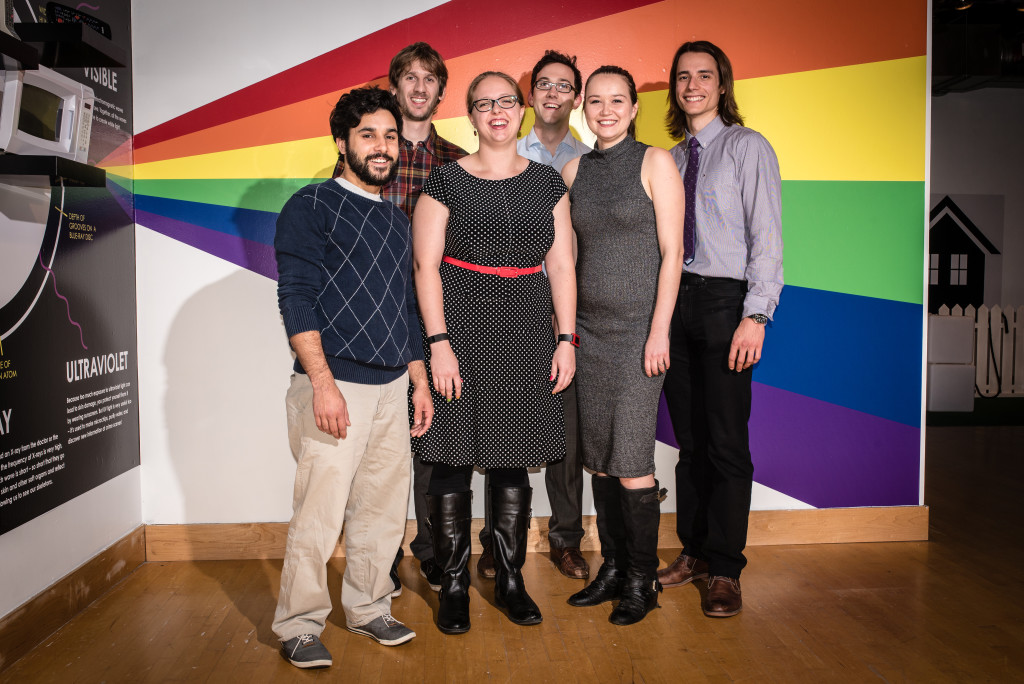
The team who brought this all together. From left to right: Ian Andrews, Mike Mazurek, Sarah Kaiser, Kent Fisher, Aimee Gunther, and Jean-Philipe MacLean. Photo credit: Brent Wettlaufer/THEMUSEUM
So how long have you been working on putting the exhibit together?
It’s been about a year and a half. We started slowly. We used our contacts and Donna Strickland put us in touch with an optics consortium of local businesses in the region who work with light and photonics. We made a few pitches to them to tried to get interest, and that ended up being quite important. That’s how we met Teledyne DALSA, Christie Digital and Tony Mantel (under his business pseudonym Wizard Labs). Tony ended up doing a lot of our electronics prototyping.
Then it was brought to our attention that the American Physical Society (APS), had a grant for outreach. We got some help from the IQC because I’d never written a grant in my life. That grant application forced us to plan fully and make a strict budget. It forced us to make it a tangible idea. We ended up winning the grant so that that was a great start.
We didn’t realize how expensive exhibits were. In the beginning, we tallied it all to be ten grand after thinking very deeply about the cost of everything. Then signage came to eight or nine grand on its own.
To make things look beautiful is very expensive, and to make them safe and robust. These are challenges that we don’t usually face when we do outreach. We have a very active communications department at IQC, so a lot of us have experience doing outreach with other community groups like Let’s Talk Science and Engineering Science Quest. But when we show a demo here at IQC, it’s put together with parts from the lab, you have a grad student guarding it and explaining stuff, and it’s fine. But you can’t just leave that in a corner of a room and have a bunch of five-year-olds come up and start playing with a laser. So it became a significant challenge to figure out how to beautify and how to make it safe and robust in a way that our IQC demos never are.
What was the brainstorming stage like?
We spent one Saturday, all day, in front of a giant whiteboard. The easier route would have been to take a first-year optics textbook and to look at all the chapters. But we just did it ourselves, proving that we still remembered our optics.
Along the way, we connected with the Knowledge Integration students. Knowledge Integration is a department here on campus. Their capstone project is to create a museum exhibit. Some of the students were interested in our project, and those students taught us ‘Museum 101’. They taught us things like how to create a flow from one place to another. They helped us to write text that made sense especially for grade 4’s. (We were aiming the exhibition at the grade four level.)
We did a lot of thinking about all the effects of optics and the actual layout of the floor space. How could we physically flow around? Because you can’t make the design open-concept if the space you’re using’s got corridors and corners. There’s a start location and an end location. So how do you want to flow the ideas and build them upon one another? There was a lot of iterative work between the ideas and what’s possible, what’s safe, and what makes sense. The exhibition is definitely directed. You have to go from one place to another.

The corners and corridors of the Light Illuminated exhibition. Photo credit: Brent Wettlaufer/THEMUSEUM
That’s a really good point. I hadn’t thought about how much floor space will influence how an exhibition is designed. With regards to building and prototyping stuff, how did that get done?
The staff of THEMUSEUM did a lot of work. Gustavo prototyped and built a lot of the exhibits, all of the wooden things. The electronics were mainly done by Tony Mantel from Wizard Labs. He took it on as kind of a fun volunteer project because he really enjoyed it. He was a hero for that.
When did you approach THEMUSEUM about doing the exhibition?
I think it was quite early on. Brent was invited to a meeting quite a while back, but the IQC does have some connections with THEMUSEUM. The physics department back in the day did an optics exhibit a real long time ago.
We officially met at THEMUSEUM a few times, and everyone seemed to be receptive to the idea. Bringing in a community project like us, with a bunch of community workers and volunteers to do something local fit under a lot THEMUSEUM’s pillars. So that was good for them as well. They wanted to reach out and be very inclusive.
What was the most enjoyable part of creating Light Illuminated?
I think it was working together as a team. We had to learn a lot of skills along the way, and we spent eight days locked in the fourth floor of THEMUSEUM with a lot of Kanye West and Michael Jackson and sliding around in socks. We ended up getting along quite well which was good. It was a great team effort. The bonding experience and realizing that it wasn’t just one person or me. It was truly a ‘We’.
What was the biggest challenge?
The fact that this was a volunteer project that had very strict deadlines attached. For example, I had to sign a document that said, “Yes we will have an exhibit in there on this date.” That was a very frightening thing to sign. Because a lot of us had classes. We had research responsibilities. We had other life responsibilities; this wasn’t our job. The exhibition was our extra thing, so it was hard to juggle all that.
That’s why it was good that we had a large group because someone was down for the count at any given time for other requirements. One semester I think five or seven courses were being taken by members of the group. It was very busy to balance homework and this and that with going to meetings and meeting with companies during the week. The time constraints were probably the hardest part.
Another one of our members had their qualifying exam in the middle of the project. A few of our members were down for the count with hardcore studying too. Now that October is done my new thing is hardcore studying because on December 1st I’m doing my qualifying exam.
Well, you know a lot about light.
Yeah haha, I know a lot about light. That was actually nice, though. Because the exhibit deals with all these different properties, we had to look at the ‘big picture’ of light. I think I’ve gotten a better understanding of how it all fits together. For example, when the burner on the stove glows red, how does that fit in with infrared light? It’s good to tie it all in. I feel like I’ve gotten a better understanding of all the concepts of light and how to explain them in a coherent way.
People think that simplifying is easy. But you need to know your material so well before you can condense it for someone else to understand it.
That was a challenge. We were a little afraid at the grand opening when a few of the physics professors came in there. Our game-plan is to never read the signs because we’re afraid of finding mistakes. We were afraid that one of the professors was going to call it out and say, “That’s not how physics works.” Luckily there were six of us, so the signs went through six iterations at least.
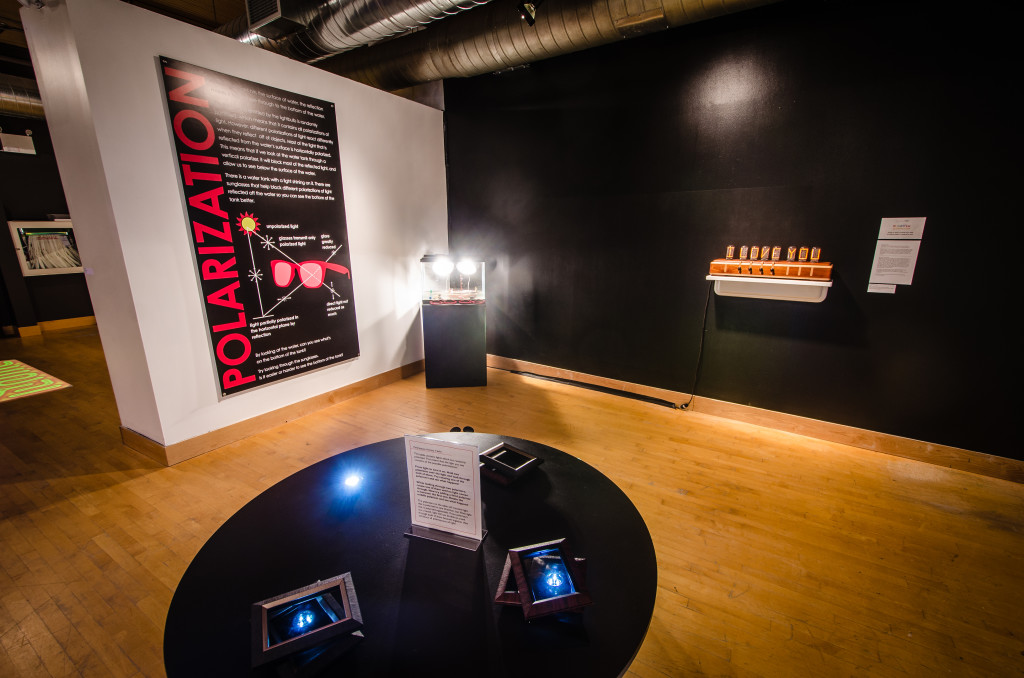
Polarization in a feature of light that affects us every day, especially in the summer. Photo credit: Brent Wettlaufer/THEMUSEUM
What do you hope people will get out of the exhibition?

Here are what the other volunteers said when asked: What do you hope people will get out of the exhibition?
I hope that since the exhibition is quite hands-on they’ll gain a greater appreciation of light and science. Because my fear is that people say: ‘science is hard’, ‘math is hard’ ‘don’t want to do it’, ‘I don’t want to take these classes’. People can be very closed off to science. But museums can be a great access point. Museums say, “Here’s a fun, interactive way to learn about this property.” And museums can give real examples so people can see without the stigma of school and textbooks. They learn about science and understand it in a way that’s non-threatening. There’s no test at the end. You just get to be there and enjoy yourself. You don’t have to take everything. Just take away as much as you want.
That’s a great point. What other roles do you think museums and science centres can play?
It’s just really important to have a non-stressful, no-pressure, inclusive way of bringing the community together in one building so that they can experience science or culture together. And that was what I was hoping we could get out of this. As we’ve been working with THEMUSEUM for the last year, it’s been interesting watching their other events. Seeing how their staff members work and seeing what exhibitions coordinators do and how exhibitions are created and brought in and then fully rounded out with additional programming. It was really neat to see.
There’s a lot of culture involved in bringing groups together to learn new things and get experiences that are outside of the everyday. That’s what I hope for people who come to Light Illuminated; this is outside of their everyday cares. But not really. They deal with light every day. They have their sunglasses on with their cellphone, they turn their cellphone sideways and then get angry when they can’t see anything. That’s polarization. That affects them every day, especially in the summer. So we want people to be able to say, “These cool facts about everything around me are because of these scientific principles. So studying science and light is important.”
What was especially great was that this exhibition was created with the help of a lot of local businesses. This demonstration had to deal with light in the community. We had the optics from Christie Digital and Teledyne DALSA and FiberTech Optica and others. They demonstrated their stuff, and they were like, “We are a company that’s building the local infrastructure. That is a part of this local community and we work with light. Light is an important part of our business.” That was really important. People get to see companies and businesses that value culture.
Taking it back to the hands-on activities. Possibly my favourite piece in the whole exhibit is the Refraction in Action activity with the lenses. I did lenses and ray diagrams in school but we never actually did it physically. We just drew lines and we were told that’s how it works, but actually seeing it and making manipulations yourself is so powerful.
We spent at least one meeting where we turned all the lights off and put all the curtains down and played with that piece. It’s really neat. We were solving research problems with it. We were trying to figure out how lenses worked for a particular experiment. And we measured different focal lengths to figure out which lens would be used where. It was fun.
Pieces like that are why I like science centres and museums. In school they’ve got to cover so much material as quickly as possible that I didn’t get a lot of hand-on experience with these principles. It was a lot of ‘read this and do these problems’. Understanding how refraction works and understanding the calculations involved is very important but seeing light rays bend in a lens in real-life is mindblowing. I never got to do that in high school.
I never did that either, and it fits in the grade ten curriculum. And what a great opportunity to go from struggling with drawings on paper to instant ray tracing without the rulers. I think almost every lab should have one of those. Just to teach undergrads or new grad students how lenses work. And it’s quick. It’s so quick. And it sticks on a white board.
Also, there’s an element of play to it. I have so much fun with the lens activity.
I think we spent the most time on that one. Because that one we built from scratch. They do sell kits and we modeled it after that kit with those cool activities, but we built the museum activity from acrylic in a machine shop ourselves. So that exhibit we spent the most time on. Things like figuring out how to get the magnets on the back of the lenses. Then there was the issue of working with lasers in a safe manner. That was the tricky thing. Where was the line between “caring for the patron” versus “it’s fine just don’t stick your face in it” It’s tricky. We thought a lot about that.
We had the Fire Marshal come in to check the exhibit before the opening and he was actually quite interested with the refraction piece. As we were still sitting on the floor building stuff, we explained how the eye works. And again there’s that physical element of explaining things that people through experience.
What advice would you give to students and graduate students interested in creating museum exhibits about their work?
So I thought a lot about this one. I think the best method is getting in touch with the communications departments either in your faculty or the department or institute. Their job is to share all the research that grad students and researchers do to the general public, and they would always appreciate getting help to explain things.
We went through all our connections. We’ve been on campus for a while volunteering with different organizations: Let’s Talk Science, Engineering Science Quest. A few of them we’ve worked with along the way. We talked to them. What did they think? How would they talk about this? What sort of things would they build?
After we had gone through all our rounds communicating with all the various science communicators, we pitched it to Kelly McManus. She’s the Senior Director of Community Relations at the University. We said to her, “Look, we could unite all these different parts of campus together to talk about light. And we could do this to represent the university in a really neat way.” She gave us a lot of advice and inevitably some support. The opening event was thanks to the University of Waterloo.
It was good, and we met a lot of people along the way. Angela Olano had a lot of experience with exhibitions in the past. She’d worked with THEMUSEUM for ten years I believe, so she was able to give us a lot of wisdom about how museums work and how you approach them to build exhibits. The Knowledge Integration department was a great resource.
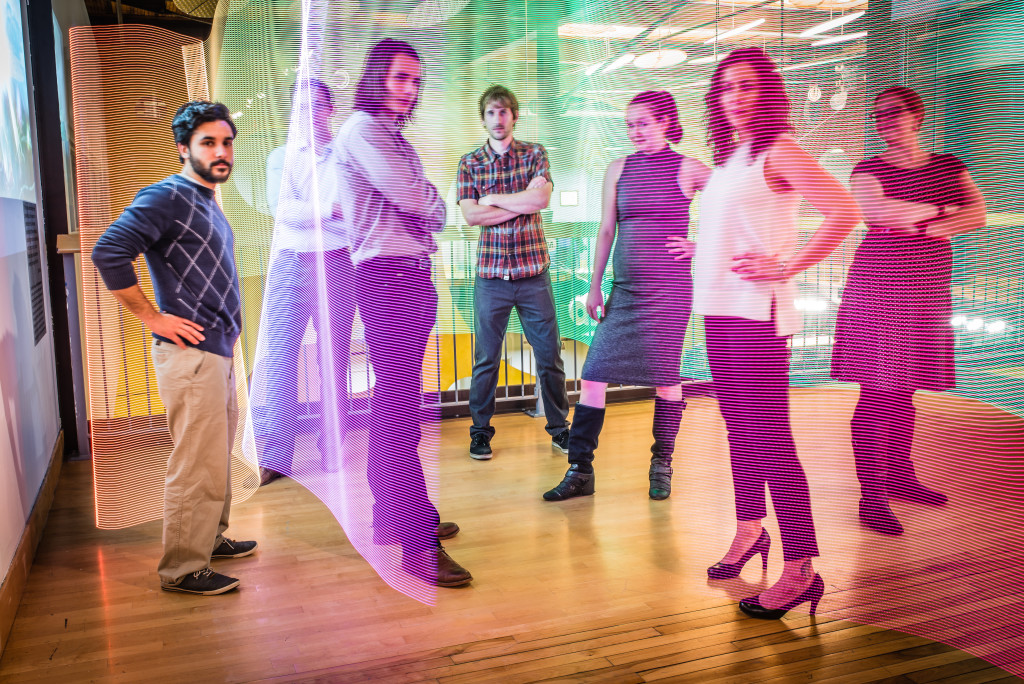
The Team looking fabulous with the pixel stick. From left to right: Ian Andrews, Kent Fisher, Jean-Philipe MacLean, Mike Mazurek, Aimee Gunther, Angela Olano and Sarah Kaiser. Photo credit: Brent Wettlaufer/THEMUSEUM
So the exhibit’s going to be up until March?
The end of March, which is supposed to coincide with the closing ceremony of the International Year of Light. I think it’s in France. They opened it sometime in February so the official closing ceremony will be in 2016. So we’re matching with them to close the exhibit off. We’re hoping to bring in a speaker series. We spoke to a lot of interested partner companies who wanted to do something but whatever they planned to donate wasn’t going to be used for that whole stretch. So a few companies are interested in doing a Sunday afternoon speaker series. And us students might fill in one of slots.
So the speaker series will be for the last month?
I think we’re going to weave it throughout the whole thing. I’m not sure what us students are going to talk about. Probably what we study. That’s future problems. We know things about light, we’ll talk about light in some way or another and how we use it. And that’s good because the science in Light Illuminated was really pitched to grade four to match the grade four curriculum of light and the grade ten curriculum. But it would be great to have some more adult content. Some higher level broader range stuff as well to fit into the museum’s mandate of transcending knowledge for everybody. And who knows maybe we could have a fun party event along the way because light’s a great medium for having fun.
Any other thoughts you want to share about the project?
The real challenge of making this exhibit was to make things safe and beautiful. There was a real struggle to be ‘museum-worthy’. We visited a few museums along the way. We all went to the Ontario Science Centre. We went and visited many different places and now we’re all very critical snobs of museums at this point.
But how do you explain something in a safe and gorgeous way? That was something that we never cared about when we do science demos. Those demos were just built and with the right supervision they were safe. So the project was taking it to that next step, for us to become light artistes.
We learned a little bit along the way about art. We have a few pieces of art in the exhibit. There’s the infrared photo of Niagara falls and the RGB colour mixing pieces. So we also had to learn the process of getting art into an exhibit. We toured the fourth floor of THEMUSEUM many times throughout the last year, and we saw at least two or three exhibits that were in that spot. Some of them were art exhibits. So it was interesting to observe how they build flowing exhibitions out of non-interactive pieces. Each painting needs room to breathe. Which I have learned quantitatively to be at least 15 inches. So it was really neat learning about that.
Light can be used for art. It’s definitely a medium that a lot of artists use. Mostly in photos but we had the piece “From me to you”. That’s an interactive piece, and it’s a piece of art that uses light as its main medium. So there are a lot of interesting pieces. It would have been nice to get a few more in. We wanted to show that light can be used in science and technology we have that whole room in there, it’s important for everyday life, but it can be used in art and culture too. So it’s with us everywhere.
I’m glad that we all managed to survive it and achieve it. It was a really good day on Thursday at the opening. We just looked at the photos this morning. There were some good photos. We were looking at all the pixel stick photos. What a great thing. All those pixel stick photos of us being all cool. I’m glad that we were able to celebrate that over-a-year-and-a-bit of hard work. I don’t know how many people did show up, but we filled the space well. It was cozy. It was a good amount of people. Everyone seemed to appreciate and to enjoy what we’d done. It was nice that we had a good send-off.
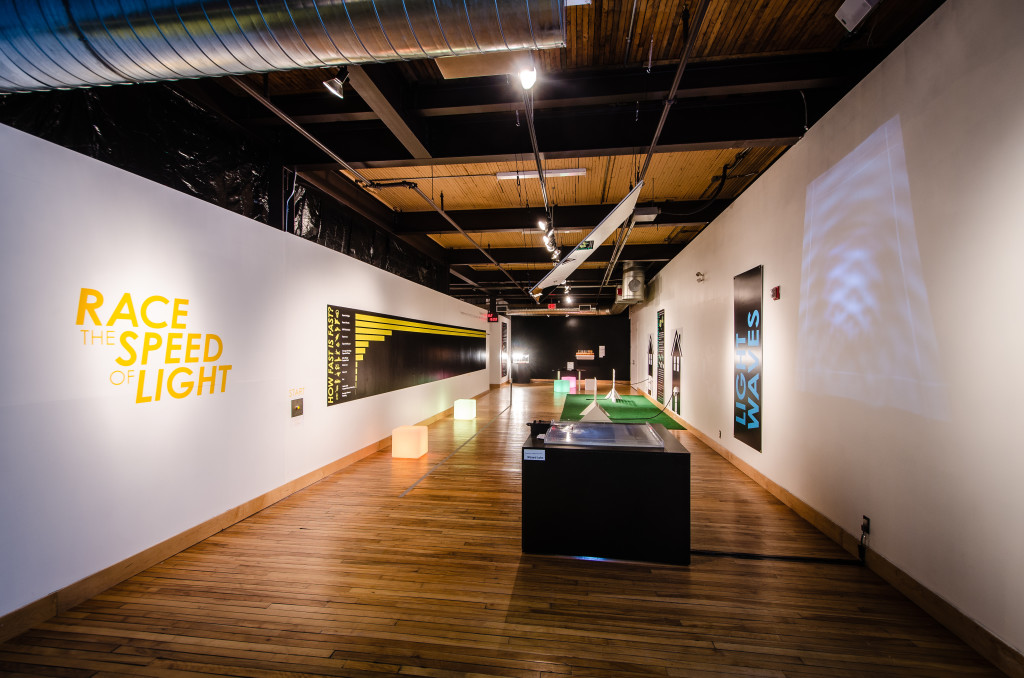
The first thing you see when you enter ‘Light Illuminated’. Photo credit: Brent Wettlaufer/THEMUSEUM
Light Illuminated opened this October and will be on display until the end of March 2016. If you’re in southern Ontario, I highly suggest you check it out at THEMUSEUM.
Cheers,


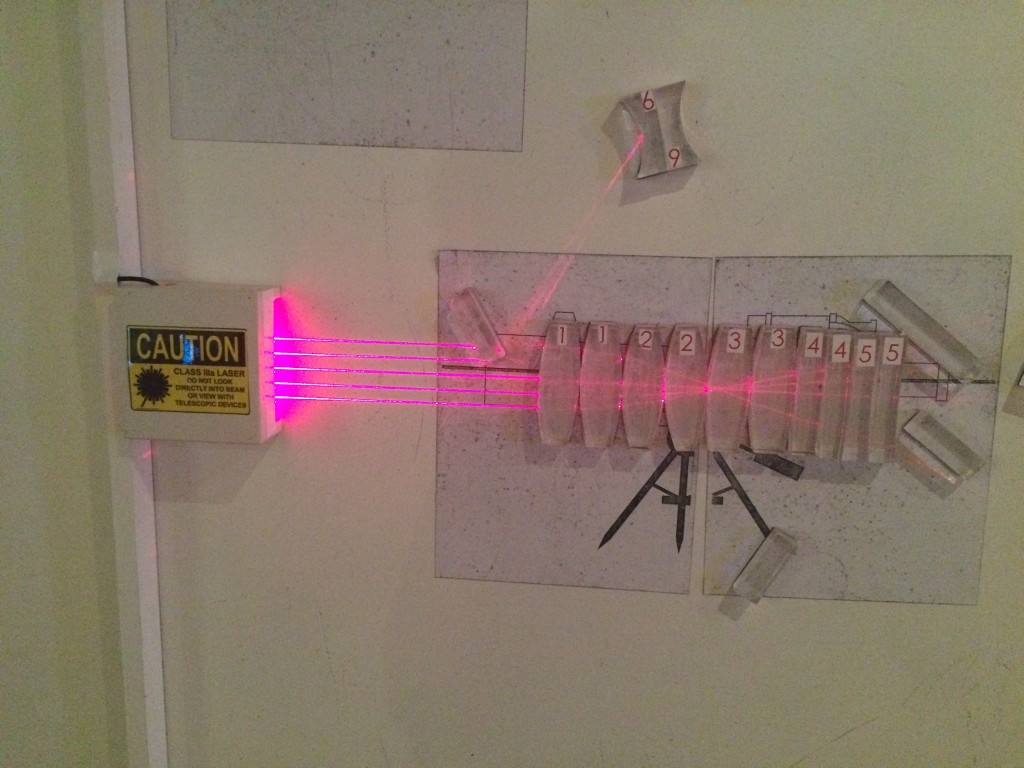

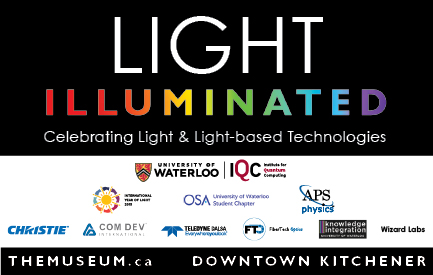
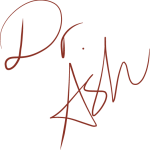
No Comments